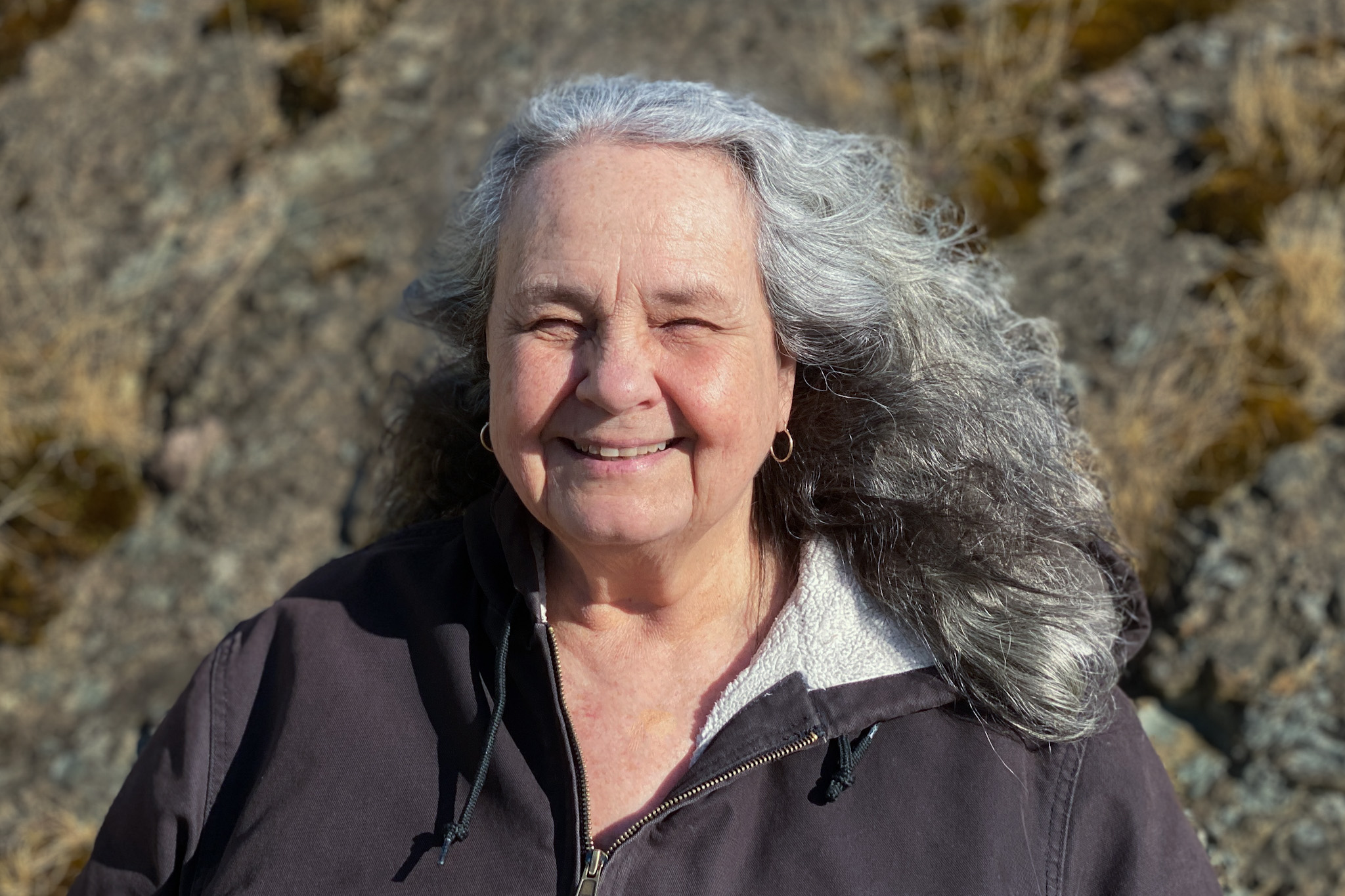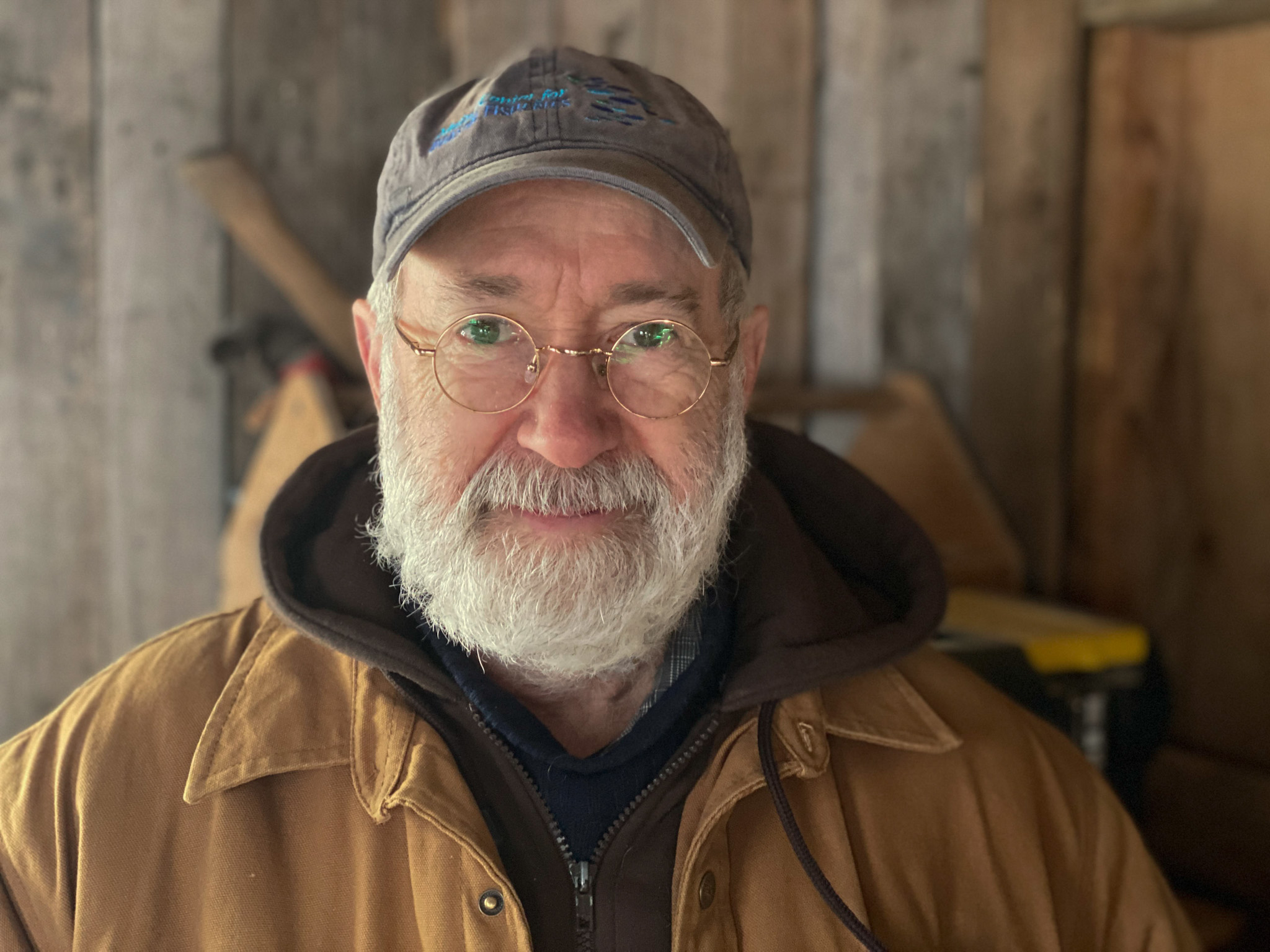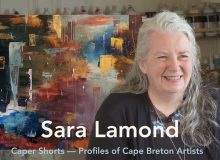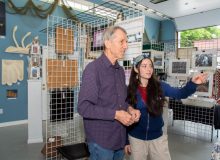Ron Williams: Folk Art as Ground Truthing
Through ground truthing, Ron Williams transforms his forestry experiences into vivid—and hefty— brilliant Tremclad folk paintings.
Ron Williams calls his vibrant folk paintings of landscapes, animals, and plants ground truthing—a term borrowed from his years as a forestry technician. “You can’t know a piece of land from an aerial photo,” he says. “You must actually get feet on the ground, walk around on it.” For Ron, painting is a way to ground truth his own experiences, memories, and decades of hiking and paddling thousands of kilometres around Alberta and Nova Scotia.
Completely Self Taught
In true folk art tradition, Ron is completely self-taught. He didn’t start painting until he retired in 2016 and says he has no idea where it came from–and no idea where it’s going. He says no one in his family had even a shred of creativity and confesses that at first he couldn’t even draw. “I don’t mind admitting that I traced. I couldn’t draw anything then. I don’t do it anymore, because I found, amazingly, as you do more, eventually you learn how to sketch and draw.”
Much of his progress is due to the sheer hard work of painting every day, all day, but also from a forced solitude. His partner, Karen Roy, is American and must return south for six months each year. They live in West Arichat on Isle Madame, off the southeastern corner of Cape Breton, and during the pandemic, he was without her for 21 months—a long time to be alone.
An Artist in Demand
But his work has gotten so good that in 2023, he was accepted at the province’s most important folk art event, the annual Nova Scotia Folk Art Festival in Lunenburg, NS, and has been invited back twice, including this August. He also has a solo show this June (2025) at the Chester Arts Centre in Chester, south of Halifax, as well as one at the Eltuek Arts Centre in Sydney. And on the west side of Cape Breton, he’s in talks for a show at the Inverness County Centre for the Arts.

A Strange Choice of Medium
But he’s chosen an unusual medium for a serious artist: He works with Tremclad rust paint on used tent canvas stretched over either salvaged boards or over old wooden window frames. Why?
It started with an imaginative exercise inspired by his decades working in remote areas. “I just thought, okay, you’re an old guy out in the woods doing whatever, (say) trapping. You’ve got no resources. You can’t get to town, but you want to decorate your cabin. So you go to the shed, and you see what you got out there.” What Ron had was a huge old outfitter’s tent, a bunch of old wooden window frames, and Tremclad paint.
Because of the nature of the rust paint, he can’t let colours mix or blend; instead, he might use layering or Pointillism techniques which allow the observer’s eyes to blend the colour. And because Tremclad doesn’t come in that many colours he has a limited palette. But Tremclad is bright, which makes his work vivid, colourful, and full of contrast.

This Wetlands painting is a perfect example of his style and it’s the one he’s most proud of—so far. It’s a compilation of many of the wetlands he’s known intimately, full of motion and life, down to the ticks, ladybugs, and caterpillars that sit on the edges of leaves.
In the undulating band of water, there are speckled and brook trout swimming by as if in a parade; and there in the corner, you can see a spotted sandpiper strutting on the beach. Look closely and you’ll be rewarded with glimpses of delightful creatures like the yellow-spotted and red-backed salamanders, frogs, as well as flying insects like the dragonfly and butterfly. And all of this on a background of flowers arranged like a mosaic, with distinct patches of colour blending together.
A collector from the U.S. is interested in purchasing Wetlands, but for Ron it’s more than a monetary transaction for Ron. “I will not sell these big ones (paintings) to anyone who is not prepared to sit down and get the entire story about them, about the experience that led to that painting, and the understanding of why it’s important to me.” He says, “I remember individual trees that are special in these areas, let alone the whole painting and its flowers.”
Post-Traumatic Embitterment Disorder
As you can imagine, after 40 years working as a forestry technician, Ron has amassed a lot of wonderful stories about the natural environment. But in the last couple of decades, he says the unnecessary destruction of the natural world has left him with what he calls “post-traumatic embitterment disorder.” Black humour, perhaps—the kind nurses and doctors resort to for coping with the uncopable—in this case, watching precious environments sacrificed for greed. Another term for it might be ecological grief.
He says, “Political interference and influence, and pandering to industry with no transparency or accountability,” has led to clearcutting being ramped up in a major way since 2000, and he wants to tell that story. He wants to paint his truth—a truth that contains some humorous but sharp criticisms, like the painting Trees of Nova Scotia.

The clear-cut that broke his heart, though, was near Guysborough, Nova Scotia. “It was a big open stand of old growth hardwoods. It was parkland, and waist high ferns all underneath. And in the Spring there was nothing but spring beauties and lilies. But it’s gone.”
He reacted through art. “You’re going to cut it down? I’ll build it back up, and that’s it right there,” he says speaking about paintings similar to the spirit that Tracadie Hardwoods below was painted. “That’s in memoriam to that stand. But in doing that, it also represents all the different trees I’ve seen that I liked.”

Ron eventually left his job at the Nova Scotia Department of Natural Resources because, as a forestry tech, he felt complicit in that destruction since the department existed to serve industry.
He transferred to Protected Areas which was part of the Department of the Environment where he believed that he could do some good. He worked there for 18 years until 2020 and says he can point to many areas he had a hand in placing on the protected list. However, he’s not naive. He says protected areas can be unprotected and there are entities that are relentless about getting those areas developed.
But he says, “It’s not my problem anymore. It’s a terrible thing to say.” Still, he’s grateful for all the opportunities being a forestry technician gave him to experience so much of what many will never see. “I got to see wild rivers, and hiked and climbed the mountains; and the mountains up there (Alberta) are just amazing. Ridge walks, you know, I did all these things. And I never would have done that without that job.”

Mining Memories
“I can’t get out to do what I did five years ago, ten years ago. I’m stuck at home and, just simply, I’m mining those memories.” He says he has a whole treasure trove of ideas from all those years, all those miles, and all those photos. Checking out his Instagram feed you’ll see scores of his folk paintings stating his truth of the woods, lakes, bogs and beaches (and bears) he’s seen and he still has many ideas for more.
And he says he’s just now starting to get into his Alberta years; he was born in Red Deer. He says, “Now, I’m teaching myself how to paint mountains.”

As we’re leaving, Archie feels the need to take a shot of his workbench in the entryway. He did not build a new workshop as a younger aspiring artist might have done. He made use of what he had, a corner of a very small room that must also accommodate the firewood for the stove in the kitchen.
Over his workbench there are some of his earliest works displayed prominently for visitors. They are the other extreme of the riot of colour and detail of his later work.
But reflecting on his growth as an artist, he says, “I’d like to go back to the innocence a little bit. The original simplicity.”
Perhaps this will be a cycle of reducing things down to essentials, to another level of ground truthing. Perhaps it could be an antidote for embitterment disorder. “I’m painting my truth and it’s more about the good than the bad.”

A Ron Williams Gallery










Author details
Elaine Mandrona, in addition to being a writer, is a painter and sculptor. She moved to Cape Breton permanently in 2021.

Author details
Archie Nadon, writer and photographer, left Ontario in 76 dreaming of living by the sea. In 2021 it finally happened.







